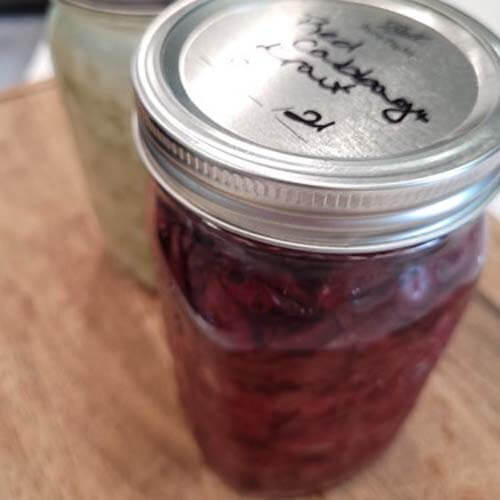
Homemade Sauerkraut
Making your own sauerkraut is a cost effective way to save your cabbage, and homemade sauerkraut is considered more nutritious than store-bought due to the processing.
Equipment
- Sauerkraut Pounder or Wooden Spoon
- Fermenting Weights
Ingredients
- 3 ½ lb. Cabbage, Red or Green
- 2 T. Sea Salt per 3 ½ pounds of Cabbage
Instructions
WASH YOUR CABBAGE:
- Before cutting the cabbage, reserve an outer leaf.
- Check your receipt or weigh your cabbage and make a note of its weight.
- Cut the cabbage into quarters.I cut mine into quarters because it fits in my bowl better.
- Wash your cabbage in the vinegar wash for 2 minutes.¼ cup distilled white vinegar to 10 cups of cool water in a large bowl for 2 minutes and rinse.
PREPARE YOUR CABBAGE:
- Shred, or cut the cabbage into bite size pieces.I typically cut mine into thin pieces with a knife.
- Transfer the cut cabbage into a large bowl and sprinkle with sea salt.2 T. for every 3 ½ lbs. of cabbage.
- Once all the sea salt has been added, squeeze the cabbage with your hands for a few minutes to help release some of the liquid into the bowl.
- Let the cabbage sit in the bowl for 30 to 60 minutes.
- Pack the cut cabbage into a glass jar large enough to hold all of the cabbage and all of its liquid.
- Using a sauerkraut pounder* or wooden spoon, press and squeeze the cabbage in the jar to remove any air bubbles.Be aggressive with this and push hard.
- Pour all the juice from the bowl into the glass jar being sure to cover the cabbage.
- Take the cabbage leaf you set aside and cut it in half.
- Take half a cabbage leaf and place it in the glass jar. You want to cover the top of the cut cabbage. Push to get all the cut cabbage under the liquid.
- Place a fermentation weight on top of the half leaf of cabbage.
- Place the lid on the glass jar and put the glass jar on a plate or bowl. The bowl/plate will catch any liquids escaping during the fermentation process.
ALLOW CABBAGE TO FERMENT:
- Leave the glass jar on the counter for three days.The sealed jar will begin the fermentation process on your counter.
- Uncover the jar daily to release any buildup of gasses.
- After 72 hours, remove the lid, fermentation weight, and cabbage leaf.
STORE YOUR SAUERKRAUT:
- Replace the lid and store in your fridge for up to one year. You may want to mark the date on the jar with a Sharpie marker.
Video
Notes
Here are a couple of tips to help get the most out of your jar of sauerkraut.
- Keep the liquid above the cut cabbage. This will help keep the mold away if the liquid is covering the cabbage.
- Use a clean serving fork or spoon to grab your kraut out of the jar keeping extra food from falling into the jar and contaminating the brine.
- When you are done dishing out your tasty kraut, put the lid back on to minimize the risk of anything unwanted getting into the jar.
- Place your kraut back in the fridge and enjoy again later!
Nutrition
Calories: 20kcalCarbohydrates: 5gProtein: 1gFat: 0.1gSaturated Fat: 0.03gPolyunsaturated Fat: 0.01gMonounsaturated Fat: 0.01gSodium: 197mgPotassium: 135mgFiber: 2gSugar: 3g